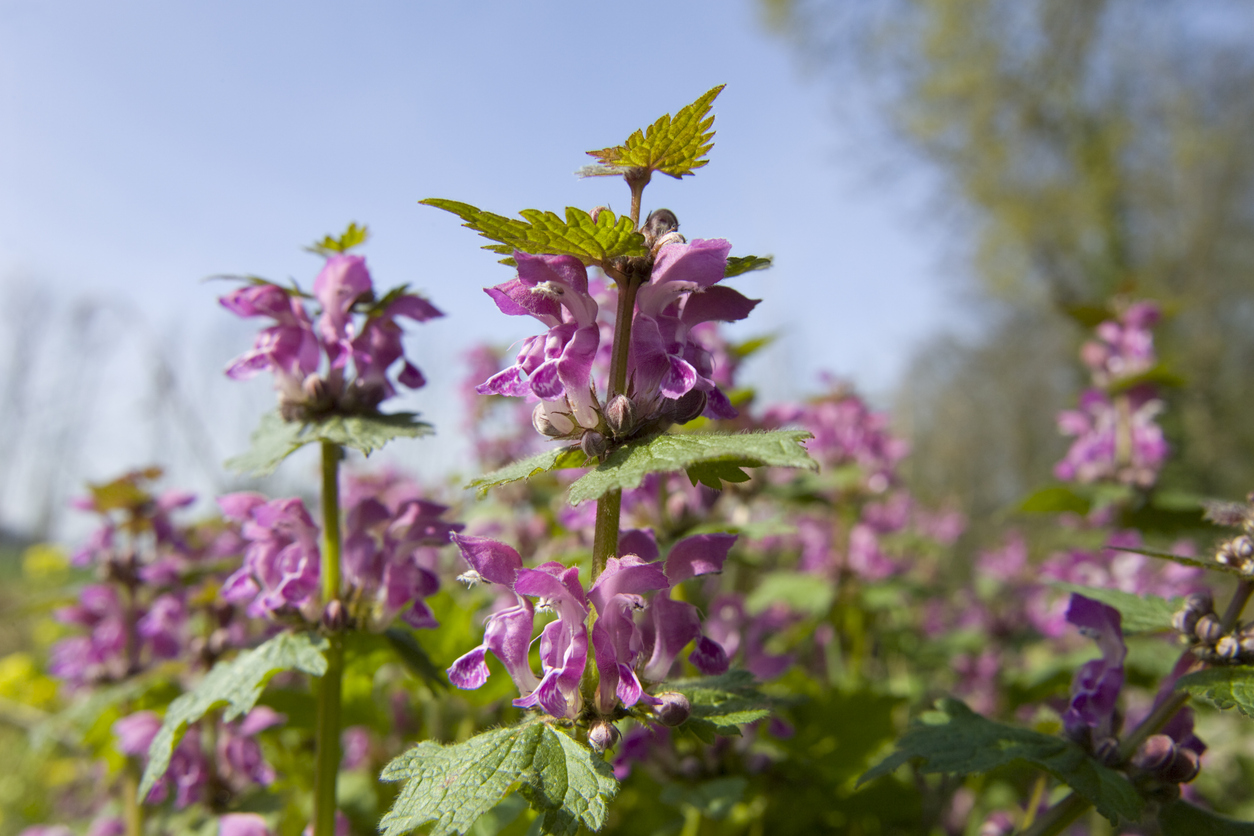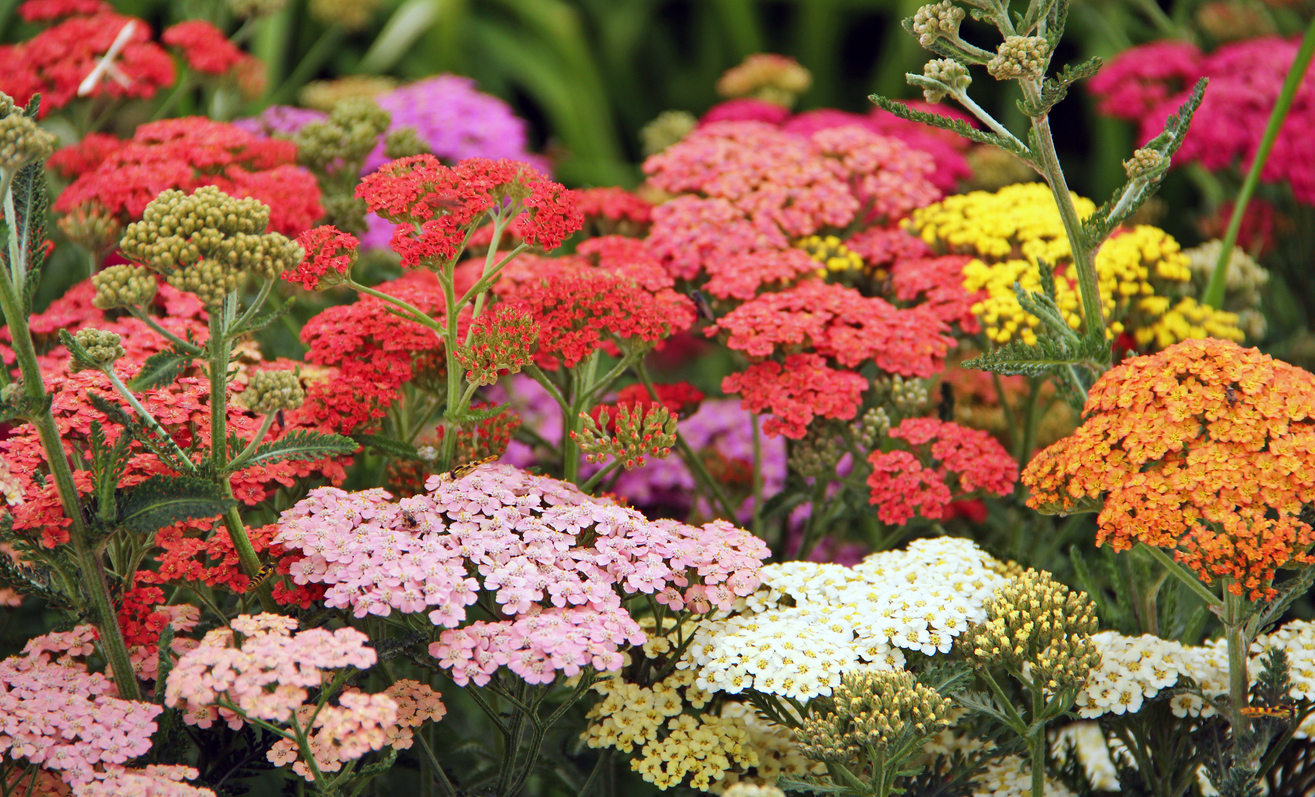We may earn revenue from the products available on this page and participate in affiliate programs. Learn More ›
Perennial plants can live for years, even decades, adding beauty to your garden with very little care. Flowering perennials typically produce blooms by the second year, though some will burst with color the very first year. And spring perennials? Well, can you think of a better way to chase away the winter blues than with pretty pink, yellow, and purple hues?
Fall, with its combination of still-warm soil and cooler, wetter weather, presents the ideal opportunity to encourage root growth in new spring perennials. So admire the varieties here, pick your favorites, and set the stage for spectacular spring flowers.
Why plant in fall for spring flowers?
Planting perennials in the still-warm fall soil gives the plants a chance to get established underground, building a strong root system that will prepare them for vigorous aboveground growth—and flowering—come springtime. If you live where it’s blisteringly hot, wait until temperatures cool down, but don’t wait so long that the plants won’t have a chance to get somewhat established before a freeze hits.
When planting your perennials in autumn:
- Fertilize with a slow-acting organic fertilizer; avoid high-nitrogen fertilizers.
- Add a 2- to 3-inch layer of mulch.
- Water your newly installed plants frequently if Mother Nature hasn’t yet sent the rains.
You may wonder about plant availability in autumn, since spring is typically the time gardeners rush out to stock up. The good news is that many garden centers are wising up to fall planting and increasing their stock at that time of year. You may also be able to order bare-root plants from online stores.
If plant- and root-chewing rodents are a problem where you live, take steps to mitigate their presence, as freshly installed plants might be a target of their winter hunger.
RELATED: Solved! What is a Perennial?
1. Hellebores (Helleborus)

If you get impatient for posies as the winter drags on, put in hellebores now. Also known as Lenten rose, this is one of the first flowers to appear each year, often poking through the snow with big, bowl-shaped pink, yellow, or maroon blooms. Hardy hellebores do best in slightly shaded spots and neutral soils with good drainage in zones 5 to 9.
2. Pasque Flower (Pulsatilla vulgaris)

Certainly no shrinking violet, pasque flower is a showstopper with purple bell-shaped blossoms that will flourish in zones 4 to 8. Pasque is the Old French word for “Easter”, and this perennial is bound to bloom in time for the holiday (fortunately, it is also rabbit-resistant). The gorgeous garden star, which is also known as windflower and meadow anemone, flourishes in fertile soil with good drainage and full to partial sun for easy purple spring flowers.
3. Creeping Phlox (Phlox subulata)

For colorful ground cover, consider creeping phlox. Phlox is the Greek word for “fire,” and this mat-forming plant will set your landscape ablaze with small, flat, fragrant blooms in purple, pink, red, and white beginning in March. It’s a favorite for filling in rock gardens and can be especially pretty draping over a wall. Plant phlox in zones 3 to 9, choosing a spot that receives dappled sun and has sandy soil that gets good drainage.
RELATED: The Best Low-Maintenance Ground Cover Plants for Your Property
4. Virginia Bluebell (Mertensia virginica)

For whom do these bells toll? Any gardener in hardiness zones 3 through 8 who doesn’t like a lot of toil. In early spring, Virginia bluebell pops out flowers that start pale and turn a rich, true blue. They thrive in moist soil and half-sun/half-shade conditions, eventually establishing a colony of pollinator-friendly ground cover with virtually zero care.
5. Columbine (Aquilegia)

Prized for its graceful, nodding blooms, columbine is a woodland perennial, meaning it likes a shady or partly shaded location and consistently moist soil. Its white, yellow, red, or blue flowers appear in early spring and bloom through midsummer. The only caveat is that columbine is one of the shorter-lived perennials; if you love them, add a few more plants every year or so in zones 3 to 8.
RELATED: USDA Releases Plant Hardiness Zones Map Update for 2023
6. Indigo (Baptisia)

Tall, resilient false indigo flowers in late spring through fall with thick stalks and spires of small dark-blue blooms. If blue isn’t your bag, check out hybrids in other colors, including yellow and pink. False indigo likes full sun but can deal with some shade in hardiness zones 3 to 9. Drought-tolerant Baptisia beckons bees and butterflies, and is unlikely to get nibbled by deer and rabbits.
7. Astilbe (Astilbe)

It must be those long, fuzzy, pale-colored flowers that give Astilbe its common nickname: false goat’s beard. This practically trouble-free plant that blooms spring through summer is especially popular as a border plant in partly shady areas. Its flowers contrast well against broad, leafy foliage. Astilbe thrives in loamy, slightly acidic soil in hardiness zones 3 to 8.
RELATED: 20 Plants to Use as Lawn and Garden Borders
8. Sundrops (Calylophus hartwegii)

Attention gardeners in the Southwest who can’t get by on cactus alone: Sundrops (Calylophus hartwegii) are a perfect perennial pick, flowering in March through October. A member of the night-blooming primrose family, the flower opens with bright yellow petals around sunset and stays that way through the next day. Plant in partly shaded areas with dry soil in zones 5 to 9.
9. Spotted Dead Nettle (Lamium maculatum)

Shade happens—and that’s not a problem for lamium. This lovely yet tough ground cover can take on bare spots, such as beneath trees, like nobody’s business. Lamium boasts variegated foliage in silver, gold, and green along with dainty pink and purple flowers that appear in late spring and summer. This rugged plant can thrive in clay and alkaline soils, and it actually prefers drier conditions in zones 3 to 8. Tip: Deadhead flowers once they fade to encourage a new crop of blooms.
10. Dianthus (Dianthus)

For a flowering perennial that smells as nice as it looks, let dianthus adorn your landscape. This flower family offers clusters of spunky spring-through-summer blooms in a range of hues, including pink, white, yellow, and red against blue-green leaves. Dianthus, a sun worshipper that thrives in well-draining soil in zones 4 to 8, is ideal for rock gardens, containers, and borders. Its rich nectar will attract pollinators, yet deer and bunnies won’t bother with it.
RELATED: 22 Shrubs That Can Handle the Heat of Full Sun
11. Spiderwort (Tradescantia)

Tap into your spidey sense with this perennial superhero, which grows in clumps and flowers in May through July in zones 4 to 8. Spiderwort boasts three-petal purple posies that contrast strikingly with its gold-tinged, grass-like leaves. A low-maintenance lovely, it thrives in full sun to partial shade and various types of soil, including sand and clay, but it’s fairly thirsty, so keep it moist but not wet.
12. Pincushion Plant (Scabiosa columbaria)

Add pincushion plant to your autumn garden and enjoy the springtime reward of delicate lavender, pink, or white flowers borne on gangly stalks that rise in a bendy way from a clump of gray-green leaves. Perennial in zones 5 through 11, Scabiosa is moderately drought-tolerant and needs full sun. The cut flowers of this plant make a wonderful, somewhat quirky, addition to a bouquet.
13. Purple Coneflower (Echinacea purpurea)

A springtime profusion of plum-colored blooms greets those who plant purple coneflower before winter winds blow. The daisy-like flowers sit high above the medium green foliage on this clumping plant that reaches 1 to 3 feet in height. Faring well in zones 4 to 10, this hardy perennial can take a bit of shade but needs at least 4 hours of sun daily. Purple coneflower is not terribly picky about soil and is fairly drought-tolerant, wilting a bit when it needs water.
RELATED: These 10 Flowering Plants Boast the Biggest Blooms
14. Coreopsis (Coreopsis)

Occasionally referred to as tickseed but more commonly known by its scientific name, coreopsis has both annual and perennial varieties. If you’re planting in the fall, be sure to look for the perennial variety. This profuse bloomer produces scads of yellow flowers throughout spring and summer, and even into autumn. Happy in zones 4 to 10, coreopsis is drought-tolerant and likes full sun. Give it some space: It can grow 15 to 18 inches tall and spread 1 to 2 feet.
RELATED: 14 Long-Lasting Flowers for Your Yard
15. Whirling Butterflies (Oenothera lindheimeri)

The delicate, intricate flowers of Oenothera lindheimeri (also known as gaura, from its earlier scientific name Gaura lindheimeri) are said to resemble supercharged butterflies. With white-tipped pink “wings” that surround long white stamens topped with yet more pink, whirling butterflies provides a touch of whimsy to the garden. This loose, shrubby plant can grow as tall as 4 feet and as wide as 3 feet, making quite a statement in gardens in zones 3 through 9. Not surprising for a native to Oklahoma, Texas, and Louisiana, it’s drought- and heat-resistant.
16. Mexican Bush Sage (Salvia leucantha)

Gardeners in zones 7b to 10 may want to consider Mexican bush sage. In its northern ranges, this big beauty might go all the way to the ground in winter, but it will come roaring back in spring. Mexican bush sage forms an ever-expanding clump of 3-foot stalks bearing long leaves and velvety purple flower spikes. Plant it in fall to let it establish a good root system before springtime. It thrives in sunny, hot locations and is drought-tolerant once established.
RELATED: How to Design an Ever-Blooming Perennial Garden
17. Bleeding Heart (Dicentra spectabilis)

Add bleeding heart to your garden in fall, and come springtime it will bring arching stems bearing delicate 1- to 2-inch-long heart-shaped pink flowers. An herbaceous, bushy plant that’s hardy in zones 2 through 8, bleeding heart forms loose clumps that grow up to 3 feet tall and 4 feet wide. Plant this one in part shade, in moist, well-draining soil with plenty of organic material. As summer wears on, bleeding heart will likely retreat, but it will be back on display after winter subsides.
18. Lantana (Lantana camera)

A sprawling, almost vine-like shrub, lantana decorates the landscape in late spring and summer with masses of delicate flower clusters in purple, orange, pink, yellow, red, or white. It likes hot weather and is drought-tolerant once established. Lantana is perennial in zones 7 and above, and will thrive in partial shade or full sun. It can grow as large as 6 feet wide and 6 feet tall, although it typically remains lower. Butterflies flock to this hardy plant, which is deer-, pest-, and disease-resistant. Bear in mind that lantana is toxic to livestock, cats, and dogs.
RELATED: 20 Plants That Thrive Even When Temperatures Rise
19. Yarrow (Achillea millefolium)

Yarrow blooms from spring to fall and thrives in zones 3 through 9. Popular as a cut flower, yarrow is also beautiful in the landscape, with masses of umbrella-shaped flower heads gracing the tops of tall stems bearing fern-like foliage. You’ll find yarrow in a rainbow of colors, including yellow, pink, red, white, and gold. Preferring full sun, it’s drought- and heat-tolerant, but its seeds need a cool period to germinate, so it’s best to sow seeds in the fall. Yarrow can spread aggressively, so plant it in a place where you’d like to see a sea of color!
20. Cushion Spurge (Euphorbia epithymoides)

Many spurge types offer early spring color, and cushion spurge is no exception. Its small yellow flowers are surrounded by yellow/pale green bracts, creating the impression of a larger flower. The mounded plant is hardy down to zone 5. While it typically likes full sun, in very hot climates, it might need a bit of afternoon shade. Cushion spurge grows to about 12 or 18 inches tall and wide. It’s drought-, deer-, and pest-resistant, and it works well in rock gardens and xeriscapes.


